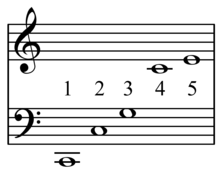



The harmonic scale is a "super-just" musical scale allowing extended just intonation, beyond 5-limit to the 19th harmonic (Playⓘ), and free modulation through the use of synthesizers. Transpositions and tuning tables are controlled by the left hand on the appropriate note on a one-octave keyboard.[1]
For example, if the harmonic scale is tuned to a fundamental of C, then harmonics 16–32 are as follows:
| Notation | Harmonics[2] | Cents | ||
|---|---|---|---|---|
| C | C | C | 16ⓘ | 0 |
| C♯ | C |
D♭ | 17ⓘ | 104.96 |
| D | D | D♮ | 18ⓘ | 203.91 |
| E♭ | E |
E♭ | 19ⓘ | 297.51 |
| E♮ | E♮ | E↓ | 20ⓘ | 386.31 |
| F | F |
F |
21ⓘ | 470.78 |
| F♯ | F↑ | F |
22ⓘ | 551.32 |
| G | G | G | 24ⓘ | 701.96 |
| A♭ | A |
A |
26ⓘ | 840.53 |
| A♮ | A♮+ | A♮ | 27ⓘ | 905.87 |
| B♭ | B |
B |
28ⓘ | 968.83 |
| B♮ | B♮ | B♮↓ | 30ⓘ | 1088.27 |
| C' | C' | C' | 32ⓘ | 1200 |
Some harmonics are not included:[1] 23, 25, 29, & 31. The 21st is a natural seventh above G, but not a great interval above C, and the 27th is a just fifth above D. Play diatonic scaleⓘ

It was invented by Wendy Carlos and used on three pieces on her album Beauty in the Beast (1986): Just Imaginings, That's Just It, and Yusae-Aisae. Versions of the scale have also been used by Ezra Sims, Franz Richter Herf and Gosheven.[3]
Though described by Carlos as containing "144 [= 122] distinct pitches to the octave",[4] the twelve scales include 78 (= 12(12+1)/2) notes per octave.
Technically there should then be duplicates and thus 57 (= 78 − 21) pitches (21 = 6(6+1)/2). For example, a perfect fifth above G (D) is the major tone above C.
|
| |||||||
|---|---|---|---|---|---|---|---|
| Measurement |
| ||||||
| Just intonation |
| ||||||
| Temperaments |
| ||||||
| Traditional non-Western |
| ||||||
| Non-octave |
| ||||||
|
| |||||||||||||||||||||
|---|---|---|---|---|---|---|---|---|---|---|---|---|---|---|---|---|---|---|---|---|---|
| Main Western |
| ||||||||||||||||||||
| Other types |
| ||||||||||||||||||||
| Ethnic origin |
| ||||||||||||||||||||
| Non-octave |
| ||||||||||||||||||||
| Modes |
| ||||||||||||||||||||
| Number of tones |
| ||||||||||||||||||||
|
| |
|---|---|
| Albums |
|
| Soundtrack albums |
|
| Musical tunings |
|
This music theory article is a stub. You can help Wikipedia by expanding it. |